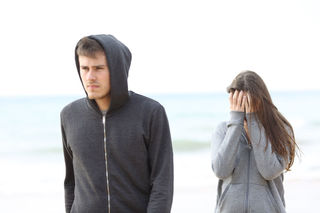Bullying
What Makes Someone Support a Bully?
It might be scary to stand up to a bully but why support one?
Posted August 30, 2019 Reviewed by Devon Frye

While I was on vacation in Ireland recently, I heard Andrea McLean, a popular Scottish journalist and the co-host of ITV’s daytime show “Loose Women,” talk about being bullied as a teen at school in Scotland. She had also spoken about the experience last November.
According to an article in Hello Magazine by Jenni McKnight, McLean said that her bullying hell began after she helped a fellow classmate who was being tormented by the same group of girls.
McLean said: "These girls were very, very viciously picking on another girl at school. She was quite a vulnerable girl, was very defenseless, and all I did was walk over and say, ‘What are you doing? Leave her alone.’”
She added: "Literally they all went, 'Now it's your turn' and that was for two years.”
I was at dinner with friends when the subject of bullying came up. That’s not at all unusual these days—it’s a fairly popular topic for discussion for a lot of reasons. However, at that dinner, one person asked a question I had not heard before: What makes people support a bully?
The answers that people came up with were actually very much along the lines of recent research— and Andrea McLean’s story reflects some of that research as well.
One study from social psychologists in Finland and California outlines three fairly standard responses to seeing someone being bullied:
- Defending the victim
- Remaining passive
- Reinforcing the bully
Despite the moral value most of us place on defending a vulnerable person who is being bullied, many responders explained that a fear of retaliation—that is, fear that they would be attacked themselves—kept them from taking any action.
This was exactly what happened to McLean. She protected the other girl at her own expense.
At dinner, my friends told similar stories.
David* told of a group of kids who used to wait for him in the morning to steal his lunch money before he got to school. He tried walking to school with some buddies, but most of them deserted him when the bullies arrived. One actually even joined in with the bigger boys to taunt him.
“That may have been the hardest thing of all—having a so-called friend turn on me that way,” David said.
One of our dinner companions wondered why David didn’t tell his parents. “That would have made it worse,” he said. “I didn’t want to be seen as a baby or a tattletale.”
Someone else said, “Yeah, that’s one of the many problems with bullies. They make you feel weak if you go to someone else for support or help. But they don’t have any problem rallying people to support them!”
This person told about a bully in his own school who attracted other bullies like magnets: “If anybody stood up to him, he had a whole crowd of guys he could sic on you.”
Lisa* said that she and a friend had been bullied by a group of “mean girls” in middle school, but she’d been lucky. Her parents had stepped in and helped both her and her friend deal with them.
Then, as an adult, she had an amazing experience when a new co-worker took an immediate dislike to her: “I’m not sure why, but she was openly nasty and critical. She worked hard to turn some of my friends against me, but I was lucky.”
Unlike the friends of David’s childhood experience, Lisa’s work friends stood with her. “They were nice to the woman,” she said, “but they each told her that she wouldn’t get far in the job if she kept bad-mouthing one of her colleagues. They encouraged her to find a way to get past whatever was upsetting her. The funny thing is that she finally did, and we became part of a really powerful, effective team.”
And Bob* talked about being chased and knocked over by a gang of boys when he was 13: “I was in the park with a friend. These kids came and pushed me. My friend ran away. I would have been in trouble, except a teacher from our school was in the park jogging and came to help, and the boys ran away.”
According to one recent study, these are the three most common responses to seeing someone else being bullied: standing by, coming to the aid of the victim, and joining the perpetrator. What makes the difference in which position someone might take?
Maybe a bully is someone who is suffering or has suffered abuse themselves, and a person standing by not doing anything is trying to protect themselves. But what makes someone join a bully?
Some psychologists, like my PT colleague Suzanne Lachmann, have clarified some of the possible childhood experiences that might explain the behavior choices of joining in with a bully—for example, possible childhood experiences of abuse, neglect, and mistreatment can lead a person to take out their pain on someone else.
A group of researchers suggests it might be something they call social contagion. According to Nicholas Christakis and James Fowler, who write about the links between our behaviors and our social networks in their book, Connected: The Surprising Power of Our Social Networks and How They Shape Our Lives, many human behaviors spread through social contact, including some that are often assumed to be biological or acquired independently, such as obesity and fertility.
Research published in 2015 in the journal Sociological Science has shown that generous and helpful behavior is “contagious”—that is, if you do something nice for someone, you increase the likelihood that they’ll do something nice for someone else.
One of the ways this works is by observation—it seems that if we see someone doing something like picking up litter, it increases the possibility that we will do something along the same lines, whether it’s picking up litter or helping someone who has dropped their groceries.
Unfortunately, the same is true in the other direction. For example, a study published in the Journal of Personality and Social Psychology found that observing someone engaging in “socially irresponsible behaviors” such as littering can lead to the same behaviors in the person who is observing them. Other studies have confirmed this kind of “contagion” of such behaviors.
From a psychological perspective, however, I would suggest yet another possible explanation. Freud showed us we all struggle with ugly, unacceptable feelings, and we often try to hide those feelings from ourselves and the world.
Supporting a bully is a perfect way to express cruelty and hate without having to own them oneself. The bully—who may actually, as Lachmann suggests, be expressing her or his own hurt, and may have some underlying redeeming qualities—becomes the fall guy for the others who are encouraging her or him. The bully gets all the blame, while the supporters get the pleasure of seeing someone else suffer and squirm, without ever being blamed for it themselves.
But here’s the thing. While bullies can do tremendous damage to their victims, they also damage themselves. And those who support them are equally at risk. Their sense of well-being and identity is, ultimately, at risk. Sally Rooney puts it this way in her book, Normal People:
“…cruelty does not only hurt the victim, but the perpetrator also, and maybe more deeply and more permanently. You learn nothing very profound about yourself simply by being bullied; but by bullying someone else you learn something you can never forget.”
Bullies and their supporters learn about their capacity to do genuine harm to others. But while bullies sometimes have the opportunity to make restitution to their victims and to find ways to resolve this part of themselves into better human beings, because bully supporters are often secretive and hidden, they don't necessarily get a chance to do so.
And while there are sometimes genuine and extenuating reasons for these behaviors, it’s self-knowledge that can ultimately be far more hurtful than what they can do to their victims.
Facebook image: Pixel-Shot/Shutterstock
References
Christakis, Nicholas A. and James H. Fowler. 2009. Connected: The Surprising Power of Our Social Networks and How They Shape Our Lives. New York: Little, Brown and Company.
Cialdini, Robert B., Raymond R. Reno, and Carl A. Kallgren. 1990. “A Focus Theory of Normative Conduct: Recycling the Concept of Norms to Reduce Littering in Public Places.” Journal of Personality and Social Psychology 58(6):1015–26. http://dx.doi.org/ 10.1037/0022-3514.58.6.1015.
Tsvetkova, Milena, and Michael W. Macy. 2015. “The Social Contagion of Antisocial Behavior.” Sociological Science 2: 36-49.




